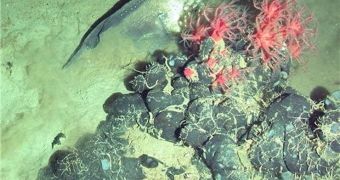A new paper in the journal Deep Sea Research Part I: Oceanographic Research Papers announces the discovery of over 2,000 mounds of asphalt – that's right, the same substance covering our roads – in the waters off the coast of Angola.
Oddly enough, these mounds are all teeming with life. Thus, researchers with the National Oceanography Center say that they serve as home to all sorts of aquatic creatures that populate the ocean floor.
How the mounds were discovered
In their paper announcing the discovery of the mounds, the National Oceanography Center scientists detail that these rather peculiar structures off the coast of Angola were found not by underwater explorers, but by oil giant BP.
Thus, it was while mapping the ocean floor in search of oil reserves that BP workers came across the mounds. At first, they didn't quite figure out what they were dealing with. It was only with the help of underwater robots that the structures were identified as asphalt mounds.
“This exciting discovery was a great example of collaboration between oil companies and marine scientists,” study lead author Daniel Jones with the National Oceanography Center commented on this find in an interview.
“By working together as a team, we used the industrial data and expertise to get a much better understanding of these important systems, which will be of great value both to the scientists, but also to the BP environmental management teams,” he added.
The details of this find
All in all, the specialists behind this investigation documented the presence of 2,254 asphalt mounds in this part of the Atlantic Ocean. Together, the mounds cover a surface amounting to 3.7 square kilometers (approximately 1.42 square miles).
It is understood that, of these asphalt mounds, some are as small as a ball and others are as big as the hills we are accustomed to seeing on land. While some sit fairly close to the surface, others are located at a depth of about 2 kilometers (1.24 miles).
Scientists say that these hills likely formed when hydrocarbons encountered salt structures and got mixed with them. Similar structures have until now been documented only in the waters of the Gulf of Mexico and along California's coastline.
Aquatic creatures really fancy them
As detailed in the journal Deep Sea Research Part I: Oceanographic Research Papers, some 21 different types of aquatic creatures call these asphalt mounds off the coast of Angola their home. More precisely, the mounds are populated by sponges, corals, octopus and even fish.
By the looks of it, sea cucumbers and all sorts of other marine dwellers also like to hang around these underwater structures. All things considered, chances are the mounds are so popular because they can help aquatic creatures keep safe from predators.

 14 DAY TRIAL //
14 DAY TRIAL //